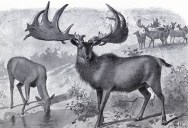This Huge Deer Used To Live In Ireland And First Emerged 400,000 Years Ago
We know by fossils and other historical records that a staggering number of species of plants and animals have gone extinct over time.
When it comes to a country like Ireland, which is an island, it’s much more likely to find a species that disappears from there, disappears everywhere.
Today, 40 species of land and marine animals, 12,000 species of insects, and more than 400 species of bird call Ireland home.
At one time, wolves roamed the forests (they were hunted to extinction in 1786), and scientists say they likely preyed on these giant deer (Megaloceros giganteus), which are also now extinct.
More commonly known as Irish Elk, these mammals stood over 6.5 feet tall and weighed over 1,500 pounds. The males had antlers that could span over 12 feet – three times as large as those we find on modern elk.

The Irish Elk thrived during the lead up to the Ice Age, and surprisingly were found other places as well, like along the western edge of Europe and east toward Russia’s Lake Baikal.
There is a painting in southern France that depicts a deer with the same enormous antlers that’s over 17,000 years old.
They were first recovered in a bog in Ireland, described scientifically for the first time in the 1690s. They’ve also been found in Asia and Northern Africa.
Paolo Viscardi, Keeper of Natural History at the National Museum of Ireland in Dublin says it’s not as surprising as you might think.
“Despite Ireland being a tiny place, we have a lot of modern deer and a lot of giant deer deposits. The depositional environment is just perfect and the preservation of these animals is incredible. There’s just this massive constant stream of giant deer turning up here.”
Despite its common name, the Megaloceros wasn’t an elk at all, but a deer. Their antlers were made of a sturdy bone that preserves better than horns that are made of keratin.

Fossils of Megaloceros have been dated to as early as 400,000 years ago and as late as 8,000 years ago. Viscardi describes what is so intersting about these deer, at least to her.
“The anatomy is just really interesting because they’re so big. I’ve handled quite a lot of them and when you pick them up, you realize just how much they weighed. It’s really incredible that an animal not only grew this, but then walked around with it every day, on its head, and managed to use it to fight with.”
Like other species of deer, the Irish Elk shed their antlers every year. Paleontologists believes that the males had very thick skulls and strong neck vertebrae in order to carry them. The antlers were likely for fighting for territory and mates.
“It was signaling to other males that you’re not to be messed with, which really helps when it comes to that in the actual nitty gritty of the fighting.”
Megaloceros grazed on available plants, but Viscardi says it may have eaten parts of animals it came across, too.
“I would be more surprised than not if they didn’t eat bits of animal remains. I suspect the males would have actually actively sought out bones and the leftovers from scavengers and carnivores to feed on. It’s something you see today with a lot of deer. They’ll nibble on bits of bone they find to get the nutrients and minerals out.”
Researchers believe that many of these animals likely died because they did not have enough time to find food between the rut and the onset of winter.
Viscardi said extreme cold probably also played a part.
“Food becoming less available and reproduction rates going down is probably what drove the extinction in Ireland. As it gets colder, the quality of the food availability goes down.”

The extinction was gradual, though, so it’s possible that the last vestiges of the species died out due to a climate that was too warm, making grasslands harder to find.
In some parts of Europe, early humans in Neolithic settlements could have played a part by removing vegetation, but Viscardi believes their influence was likely minimal.
“I don’t think there’s any really good evidence that humans turned up on the scene in Ireland, and were hunting or anything like that. It’s very much more about the climate getting less hospitable.”
These would have been something to behold.
From a safe distance, of course.
Thought that was fascinating? Here’s another story you might like: Why You’ll Never See A Great White Shark In An Aquarium

Sign up to get our BEST stories of the week straight to your inbox.




